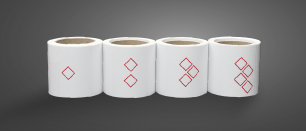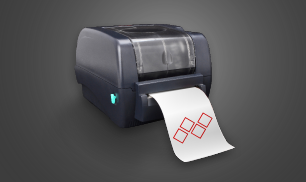HazCom Pictograms
GHS uses 9 pictograms, each consisting of a different symbol, on a white background, within a red border described as a 'red square on point' (diamond) framed border.
These pictograms are used to communicate health, physical and environment hazards, however, OSHA's does not have jurisdiction over environmental hazards, and so HazCom 2012 only requires the use of 8 of the GHS pictograms. Although not required by OSHA and considered 'Non Mandatory", the 9th pictogram depicting environmental hazards may be used on labels.
HCS Chart of Pictograms and Hazards:
Health Hazard |
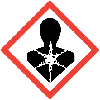
|
Flame |
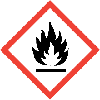
|
Exclamation Mark |
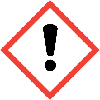
|
||
|
|
|
|||||
Gas Cylinder |

|
Corrosion |
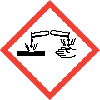
|
Exploding Bomb |

|
||
|
|
|
|||||
Flame over Circle |
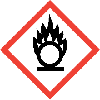
|
Environment
|
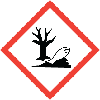
|
Skull and Crossbones |

|
||
|
|
|
|||||
Red or Black borders?
Under HazCom 2012 pictograms must have ONLY RED borders on labels - the use of BLACK borders is NOT allowed. This requirement applies whether the chemical product is being shipped in the United States or being shipped internationally.
Blank Borders on NOT allowed on Labels
HazCom 2012 does NOT allow the use of BLANK red borders on labeling. Every red border on a label must have a symbol printed inside of it. A blank red border on a label may confuse workers and lead to concern that information is missing. HazCom 2012 specifically prohibits the use of any blank red borders on labels to ensure workers have maximum recognition and comprehension of hazards.
Workplace Labeling
Employers have had some flexibility in the type of hazard communication system they use in their facilities, and that has been retained in HazCom 2012. Employers may choose to follow the newly revised rule and label their workplace containers with the same label that is on the shipped container for the chemical, or employers may use a label that meets requirements for the standard such as National Fire Protection Association (NFPA) 704 Hazard Labeling, or Hazardous Material Information System (HMIS) labeling, which are permitted for workplace containers. It is important to note that any information listed on the workplace labels must be consistent with HazCom 2012, meaning that any hazard warning or pictograms that conflict with HazCom 2012 hazard warnings or pictograms are not allowed.
Updating Labeling Information
Under HazCom 2012, chemical manufacturers, importers, distributors or employers are required to revise their labeling within six months of becoming aware of chemical hazards and ensure labels on chemical containers shipped or introduced into the workplace after that time contain the updated information.
HazCom 2012 and the New Safety Data Sheets
Previously OSHA's Hazard Communication Standard indicated what information was required on Material Safety Data Sheets (MSDS), but the HazCom 1994 did not require the use of a specific format for how that information was presented. With the revised HazCom 2012, the MSDS requirements have been changed to align with GHS which requires the use of Safety Data Sheets (SDS) using a consistent format to provide a harmonized presentation of information. The new SDS uses a 16-Section format with consistent headings, in a specific sequence. HazCom 2012 specifies what information must be included under each heading for each of the 16 sections.
The 16 Sections of the new SDS are:
- 1. Identification
- 2. Hazard(s) identification
- 3. Composition/information on ingredients
- 4. First-Aid measures
- 5. Fire-fighting measures
- 6. Accidental release measures
- 7. Handling and storage
- 8. Exposure controls/personal protection
- 9. Physical and chemical properties
- 10. Stability and reactivity
- 11. Toxicological information
- *12. Ecological information
- *13. Disposal considerations
- *14. Transport information
- *15. Regulatory information
- *16. Other information, including date of preparation or last revision
*The use of Sections 12, 13, 14, & 15 on the Safety Data Sheets is not specifically required by OSHA's Hazard Communication Standard because those areas do not fall under OSHA's jurisdiction. However, HazCom 2012 allows those sections to be used on the SDS.
HazCom 2012 and 'Hazards Not Yet Covered' under the GHS Document
Some hazards have not yet been addressed by the GHS Document, so those hazards are now covered under a category titled: "Hazards Not Otherwise Classified (HNOC), with the exception of 'Simple Asphyxiants', 'Pyrophoric Gases', and 'Combustible Dusts' which are addressed individually in HazCom 2012. Although 'Simple Asphyxiants', 'Pyrophoric Gases', and 'Combustible Dusts' are not hazards addressed in the current GHS Document, those hazards were added to the definition of hazardous chemicals in HazCom 2012, and require the use of specific label elements that include specific signal words and hazard statements. Any hazards that fall under the HNOC category are required to be disclosed on the Safety Data Sheets in Section 2, however, HNOC hazards are not required to be disclosed on labels.
HazCom 2012 Training Requirements:
Training is critical to the success of any hazard communication effort. Although the GHS Document does not identify specific harmonized training provisions, HazCom 2012 does include training requirements. Under HazCom 2012, employers are required to train employees on the new labels elements, such as pictograms, signal words, and hazard statements. Employers are also required to train their employees on the new Safety Data Sheet (SDS) format. Many other countries have already implemented, or are in the process of implementing GHS; so many workplaces will be seeing labeling that aligns with GHS arriving in their workplace prior to the full compliance dates for HazCom 2012. Ensuring that employees are familiar with the new labeling, and are able to recognize and understand the information found on the labels and SDS, will help ensure workers are prepared for the changes. Proper preparation results in increased workplace safety.
Compliance Dates for HazCom 2012
OSHA has provided a 'phase-in' period for compliance with the requirements of HazCom 2012. Employers are required to complete their training requirements by Dec 1, 2013, by providing employees with training on the new labeling elements and safety data sheet format. By June 1, 2015, manufacturers, importers, distributors, and employers must be in compliance with the modified provisions found in HazCom 2012, with the exception of shipping container labeling requirements which must be in compliance by Dec 1, 2015.
As long as the labeling is consistent with the requirements of HazCom 2012, alternative labeling systems, such as NFPA 704 labeling or the use of HMIS labels, may still be used for workplace containers. However, by June 1, 2016, employers must update any alternative workplace labeling in use, update their written hazard communication program, and provide additional employee training for any newly identified physical or health hazards. During the phase-in period, labeling and safety data sheets that follow both the old and new standard will be found in the workplace together, which is allowed by HazCom 2012. The goal however should be to complete compliance goals as quickly as possible rather than wait until the deadline is drawing near.
What are the Benefits of HCS 2012?
OSHA estimates that modifying the Hazard Communication Standard will provide many benefits. Benefits are expected to include:
- Reduction in safety and health risks for employees
- Fewer accidents, illnesses, injuries, and deaths
- Employees will have greater understanding of chemical hazards in the workplace
- Workers will be able to obtain hazard information faster and more easily
- Work practices and controls will be improved
OSHA has estimated that revising the Hazard Communication Standard will result in the prevention of 585 workplace injuries and illnesses yearly, in addition to the prevention of 43 workplace deaths each year. OSHA estimates this reduction in workplace injuries, illnesses and fatalities will save $250 million a year.
OSHA estimates that revising HazCom 2012 will also result in $475 million saved each year through productivity improvements. Additionally Harmonizing HazCom with GHS will help reduce trade barriers so businesses can compete more effectively in the global marketplace.
'Continuous Improvement Methodology'
The United Nations updates GHS every 2 years and makes revisions as needed. Because GHS is considered a "living document', it is kept up-to-date to reflect changes and new information. OSHA's Hazard Communication Standard also follows this 'continuous improvement methodology' and is also expected to change as needed to keep up-to-date.
Staying compliant with changing standards and requirements can be a challenging task. Industrial Safety Solutions is here to help! Labeling and signs are a key component of many compliance projects. With the SafetyPro Labeling printer and supplies from Industrial Safety Solutions, creating custom labels and signs for your facility is fast, simple, and affordable! With prices and quality that beat out the competition, Industrial Safety Solutions is the one to call! Contact them today, at 1-877-762-9280 to learn how SafetyPro can make all of your compliance labeling projects easier and more cost effective!

 View Cart ( )
View Cart ( )